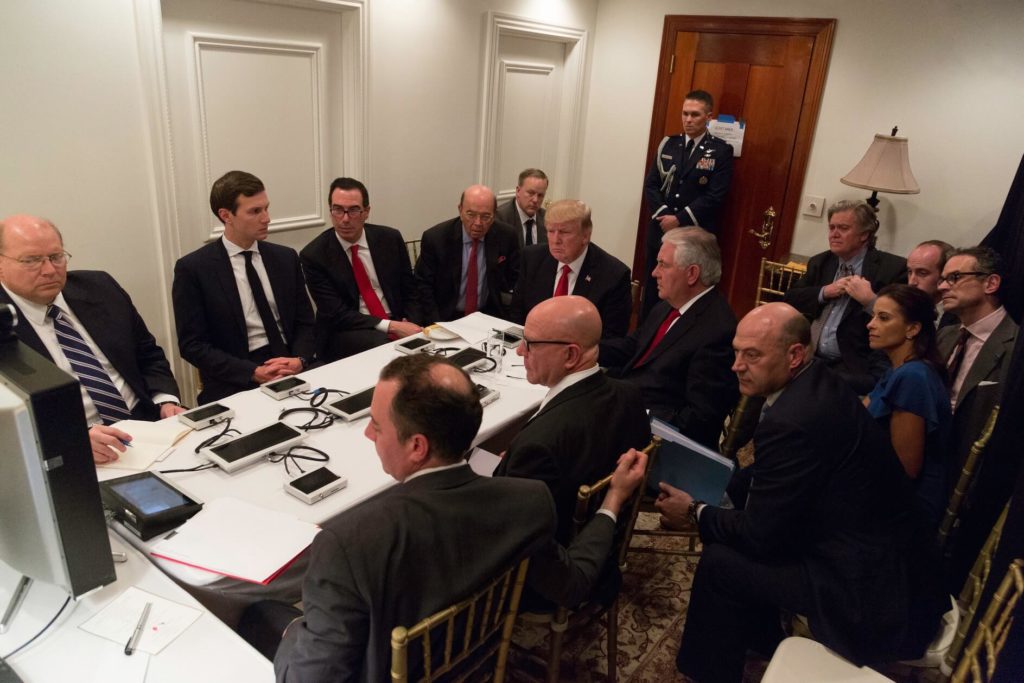
A Review of Benjamin Teitelbaum’s new book War for Eternity: Inside Bannon’s Far-Right Circle of Global Power Brokers (New York: Dey Street Books, 2020).
Steve Bannon made headlines this past week when he was arrested on the 150-foot mega yacht of a fugitive Chinese billionaire and business associate, Guo Wengui, and was charged with conspiring to cheat hundreds of thousands of donors for a private fundraising effort, “We Built the Wall” by falsely promising that their money had been set aside for new sections of the wall.[1]

Bannon’s arrest, combined with the growing popular backlash against the extremism of President Donald Trump, makes War For Eternity, Benjamin Teitelbaum’s excursion into Steven Bannon’s mind and social milieu, very timely.
Prior to his arrest, Bannon was known as the free-thinking gadfly who co-founded Breitbart News, a major platform of the alt-right. He is also a former Goldman Sachs investment banker, filmmaker, and was White House chief strategist for the first seven months of the Donald Trump presidency.
Teitelbaum is an anthropologist and professor of ethnomusicology at UC Boulder who has written for The New York Times, Wall Street Journal, and The Atlantic on Nordic nationalism and the ultra-right. The course of his research over several years has acquainted him with a century-old “philosophical and spiritual school with an eclectic if minuscule” following known as Traditionalism “—with a capital T—” he adds. His interest increased during the 2016 campaign season when Bannon began dropping names that he, Teitelbaum, knew were associated with Traditionalism, a sign that this obscure and underground movement was now surfacing in real-world politics.

Traditionalism
The most fascinating pages of War for Eternity are its situating of Traditionalism’s roots in the writings and teachings of René Guénon, a French convert to Sufi Islam, a spiritualist and pre-modern branch of Islam. Guénon posited a once-upon-a-time core religion, the Tradition, the threads of which can be found in the Indo-European religions such as Hinduism, Zoroastrianism, and pre-Christian pagan practices.
Teitelbaum prefaces his description of Traditionalism’s religious content by saying that its followers speak in “broad generalizations” with “peculiar understanding[s] of time and society.” Details in Traditionalist thought, he notes, are hard to find. Following Hinduism, they believe that human history cycles through four ages, from a Gold age of virtue through silver and bronze to a Dark age of depravity. Each stage has a dominant social caste and a social hierarchy descending from it. The Gold age is dominated by a priest caste with warrior, merchant, and slave castes beneath it. The Dark age has slaves on top. The path of regeneration and the return to virtue lead through degeneration, decay, and darkness—before things can get better, they have to get worse. Traditionalists disagree on the timespan of the cycle but tend to agree that our current age is Dark, the Kali Yuga as it is called in Sanskrit. Their belief in the cyclical nature of existence means Traditionalists abjure the possibility of progress, a staple of Enlightenment thought.
Intriguingly, given the antonymic construction of the model, Traditionalists believe that humankind was ushered into darkness by the European age of enlightenment.
It was the displacement of the symbolic and emotional by the rational, literal, quantifiable in the 17th and 18th centuries that separated the spiritualism of antiquity from the rationality and materialism of modernity, the crass consumerism of modern society that reduced relationships between people to the invidious comparisons of their possessions.
The political notion of God-given rights derived from Christian teachings—all men are created equal—abetted the homogenizing of human diversity and underwrote the modernist principles of political democracy. Christian universalism, says Teitelbaum, was then projected worldwide by religious evangelism in complicity with state-led imperialism.
Traditionalists, according to Teitelbaum, are anti-capitalist, anti-corporate, opposed to commercial civilization, cultural liberalism, and adamantly anti-globalist. Bannon’s assertion, in the author’s words, “that the working class is the fount of authenticity in inauthentic modern society” echoes the thinking of Western postmodern theorists that modernism is best at covering over the reality of class relations in capitalism and creating illusions of stability and progress; those oppressed by the system, workers and peasants, are best able to see through its façades, according to the theory.
Network Analysis
Teitelbaum uses a methodology known as “network analysis” that sociologist G. William Domhoff, author of the best-selling book Who Rules America?, developed in the 1970s to study how social and institutional connections between individuals lead to the concentrations of economic and political power.
He places Bannon in a network of behind-the-scenes influencers like Aleksandr Dugin to Vladimir Putin in Russia; Gabor Vona in Hungary who led Jobbik, the political party that energized Prime Minister Viktor Orban’s turn from the political West; and Olavo Carvalho in Brazil, said by Bannon to be the “great theorist” of President Jair Bolsonaro’s government.

Julius Evola was an Italian philosopher: an antisemitic conspiracy theorist and occultist. He has been described as a fascist intellectual, a radical traditionalist, antiegalitarian, antiliberal, antidemocratic, antipopular, and as the leading philosopher of Europe’s neofascist movement. [Source: wikipedia.org]
Remarkably though, the network’s connecting threads are not—as they were for the American power elite in the mid-twentieth century—on golf courses and in men’s clubs. The Traditionalists are networked through ideas. It is their shared attraction to the refinement given Guénon’s thinking by the Italian Aryan-supremacist Julius Evola in the 1930s. In keeping with their commitment to material transcendence, they share, not physical spaces, but intellectual space comprised of esoteric books and journals informed by Evola’s ideas which are published by an Indian startup called Arktos. Aleksandr Dugin is Arktos’s “greatest commercial and intellectual success,” according to Teitelbaum.
The War for Eternity helps make sense of the tension between President Trump and the White House medical team tasked with leading the response to the Covid-19 Pandemic.
Traditionalists are profoundly anti-modern, which means they are disdainful of science. Loyalty, on the other hand, is a premodern virtue. Once we see this dichotomy in the philosophical orientation that Steve Bannon brought to the White House, it is no surprise that when loyalty to the President conflicts with the data-driven policy choices made by scientists, the latter are brushed off, or even fired, as was Rick Bright in April when, as deputy assistant secretary of Health and Human Services, he expressed skepticism about hydroxychloroquine, a drug favored by the President for treating Covid-19.
Teitelbaum, in other words, digs beneath the cable-news talk-show banter about Trump’s incompetence and narcissism to reveal the coherence in what the President says and does within the spirit of Traditionalism, Bannon’s hallmark.
The Bumpy Collusion of Global Powerbrokers
Bannon and Trump were brought together by billionaire hedge-fund manager Robert Mercer and his daughter Rebekah, a philanthropist and major funder of the Goldwater Institute, a think tank, and the Heritage Foundation. They were financial backers of Breitbart News that Bannon headed beginning in 2012. In 2013, Rebekah and Bannon started Reclaim New York, a conservative watchdog operation, to monitor government spending. With Mercer money in 2014, Bannon created Cambridge Analytica, a data-mining company adept at the oppositional research that played a central role in the 2016 presidential campaign. In August 2016, “at the behest of the Mercers,” according to Teitelbaum, Bannon was named CEO of the Trump campaign.
Teitelbaum, however, shows us that Bannon and Trump were not a perfect match. Trump ran for office on a promise to pare back military commitments abroad—a page from Traditionalism’s anti-globalist song book. But the practicalities of doing that butted-up against the reality of the decades-long U.S. institutional presence around the world, realities represented in the White House by the “establishment types,” as Teitelbaum calls them: Ivanka Trump and Jared Kushner, the President’s daughter and son-in-law.
When Syrian President Bashar al-Assad struck rebels holed up in the city of Homs in April 2017, Trump hit back with Tomahawk missiles launched from an American destroyer in the Mediterranean. In the author’s words, it was a “’Bannon versus Jared’ moment: nationalism versus globalism, disruption versus status quo, Trump’s grassroots agenda versus establishment Washington.” On April 6, Bannon was dismissed from the National Security Council.

In August of 2017, Bannon’s comfort with the white supremacist element in Traditionalism further strained his relationship with the White House. A rally in Charlottesville, Virginia, to oppose the removal of a statue of Confederate General Robert E. Lee attracted Traditionalist headliners: Richard Spencer, head of the white nationalist National Policy Institute, and two leaders from the Swedish front of racial activism, Henrik Palmgren of Red Ice and Daniel Friberg, the CEO of Arktos, the outpost of Traditionalist publishing.


What emerged in Charlottesville said Teitelbaum, “was a gnarly mob explicitly championing white identity,” many of them wearing Trump’s MAGA hats. Counter-protesters clashed with the racists. The street battle sent dozens to hospitals and left one counter-protester, Heather D. Heyer, dead.
At a press conference the following Tuesday, Trump condemned the violence of both sides, a false balancing that was roundly criticized. But Bannon “was thrilled,” says Teitelbaum. Days later, the critics turned on him, blaming his influence on Trump for the president’s remarks. He resigned.
Menacing Back-to-the-Future Rhetoric
Teitelbaum has offered us a wonderfully written, easy to read, and profoundly thoughtful look into a shadowy White House whisperer. War for Eternity portrays Steve Bannon as an eccentric bookworm—little to worry about there. But there is little else in the book to put us at ease. Teitelbaum sees danger in the racism and antisemitism coursing through the veins of Traditionalism, and he is even more unsettled by the affinity of its followers for the notion of “the time cycle” and the path to doomsday on which it would set the world.
Bannon and his fellow travelers have influence with what the author calls a “critical mass of world leaders” whom, like Trump, pander to rural and nativist populations that are all too ready to flip-off intellectual elites with highfalutin academic degrees. Trump’s back-to-the-future rhetoric is music to the ears of Americans feeling left behind by modernism, the calls to “tear it all down” raised by the end-of-timers among the Traditionalists a dangerous incitement in a world with the nuclear arms and chemical pathogens to do just that.
The author asks, do we really aspire to be what we were, rather than dream of what we could become? This is the same question that ignited the Enlightenment four hundred years ago; it is the perfect ending to this book and testimony to the enduring human curiosity about the meaning of “progress” and what, if any, agency it has in bringing about a better world.

[1] Alan Feuer, William K. Rashbaum and Maggie Haberman, “Bannon Faces Fraud Charges in Wall Project,” The New York Times, August 21, 2020, A1. See nytimes.com.
CovertAction Magazine is made possible by subscriptions, orders and donations from readers like you.
Blow the Whistle on U.S. Imperialism
Click the whistle and donate
When you donate to CovertAction Magazine, you are supporting investigative journalism. Your contributions go directly to supporting the development, production, editing, and dissemination of the Magazine.
CovertAction Magazine does not receive corporate or government sponsorship. Yet, we hold a steadfast commitment to providing compensation for writers, editorial and technical support. Your support helps facilitate this compensation as well as increase the caliber of this work.
Please make a donation by clicking on the donate logo above and enter the amount and your credit or debit card information.
CovertAction Institute, Inc. (CAI) is a 501(c)(3) non-profit organization and your gift is tax-deductible for federal income purposes. CAI’s tax-exempt ID number is 87-2461683.
We sincerely thank you for your support.
Disclaimer: The contents of this article are the sole responsibility of the author(s). CovertAction Institute, Inc. (CAI), including its Board of Directors (BD), Editorial Board (EB), Advisory Board (AB), staff, volunteers and its projects (including CovertAction Magazine) are not responsible for any inaccurate or incorrect statement in this article. This article also does not necessarily represent the views the BD, the EB, the AB, staff, volunteers, or any members of its projects.
Differing viewpoints: CAM publishes articles with differing viewpoints in an effort to nurture vibrant debate and thoughtful critical analysis. Feel free to comment on the articles in the comment section and/or send your letters to the Editors, which we will publish in the Letters column.
Copyrighted Material: This web site may contain copyrighted material the use of which has not always been specifically authorized by the copyright owner. As a not-for-profit charitable organization incorporated in the State of New York, we are making such material available in an effort to advance the understanding of humanity’s problems and hopefully to help find solutions for those problems. We believe this constitutes a ‘fair use’ of any such copyrighted material as provided for in section 107 of the US Copyright Law. You can read more about ‘fair use’ and US Copyright Law at the Legal Information Institute of Cornell Law School.
Republishing: CovertAction Magazine (CAM) grants permission to cross-post CAM articles on not-for-profit community internet sites as long as the source is acknowledged together with a hyperlink to the original CovertAction Magazine article. Also, kindly let us know at info@CovertActionMagazine.com. For publication of CAM articles in print or other forms including commercial internet sites, contact: info@CovertActionMagazine.com.
By using this site, you agree to these terms above.
About the Author

Jerry Lembcke is the author of eight books, including The Spitting Image: Myth, Memory, and the Legacy of Vietnam, CNN’s Tailwind: Inside Vietnam’s Last Great Myth, and Hanoi Jane: War, Sex, and Fantasies of Betrayal.
His opinion pieces have appeared in the New York Times, Boston Globe, San Francisco Chronicle, and The Chronicle of Higher Education. He has been a guest on several NPR programs including On the Media. He is presently Associate Professor Emeritus at Holy Cross College in Worcester, Massachusetts, and Distinguished Lecturer for the Organization of American Historians.








